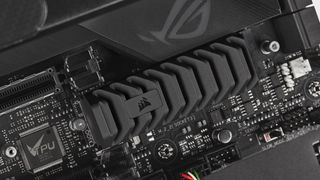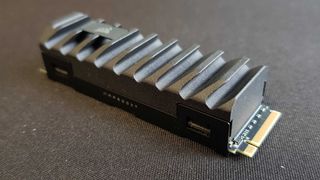Corsair's thick new SSD smokes all first-gen PCIe 4.0 drives
The MP600 Pro XT is rated to deliver read speeds of up to 7,100MB/s and exceed a million IOPS.

The fastest SSDs all leverage the PCIe 4.0 bus, but not all are created equal—in terms of rated specifications, it largely boils down to when they were released. Timing matters, because the first crop of PCIe 4.0 SSDs topped out at around 5,000MB/s. Then came a new round of memory controller hardware, which pushes speeds north of 7,000MB/s. Corsair's new MP600 Pro XT falls into the latter category, while also boasting incredibly high IOPS.
This is Corsair's fastest SSD to date. It's available in 4TB, 2TB, and 1TB capacities, and while specifications vary between the smallest and two biggest drives, all three are rated to deliver up to 7,100MB/s of sequential read performance. Here's a snapshot of the relevant speed metrics:
- 4TB—7,100MB/s seq. reads; 6,800MB/s seq. writes; 1.2 million random read IOPs; 900K random write IOPS
- 2TB—7,100MB/s seq. reads; 6,800MB/s seq. writes; 1.2 million random read IOPs; 1 million random write IOPS
- 1TB—7,100MB/s seq. reads; 5,800MB/s seq. writes; 1.2 million random read IOPs; 900K random write IOPS
The rated IOPS is where the MP600 Pro XT separates itself from the competition. Take for example Sabrent's Rocket 4 Plus, one of the best SSDs for gaming. It offers up similar sequential read (7,100MB/s) and write (6,600MB/s) specs, but the random read and write IOPS check in at 650,000 and 700,000, respectively. WD's SN850, another speedy SSD, hits 1 million IOPs for reads, but ranges between 680,000 and 720,000 IOPS (depending on capacity) for writes.
This won't always come into play—IOPS can affect performance when accessing a bunch of files that are scattered across the NAND flash memory chips. In terms of real-world usage, most users won't actually notice much of a difference, though it still speaks to the quality and capabilities of the NAND, controller, and firmware.

Best SSD for gaming: the best solid state drives around
Best PCIe 4.0 SSD for gaming: the next gen has landed
The best NVMe SSD: this slivers of SSD goodness
Best external hard drives: expand your horizons
Best external SSDs: plug in upgrades for gaming laptops and consoles
In this case, Corsair pairs Micron's 176-layer 3D triple-level cell (TLC) NAND memory chips with the Phison's PS5018-E18 controller. It's the same controller as found on Corsair's MP600 Pro (non-XT) released earlier this year (and most of the fastest SSDs on the market), but the NAND is an upgrade over the 96-layer chips the non-XT models use.
In those terms it's actually identical to the Seagate FireCuda 530 we recently reviewed, which uses the same NAND and controller, though is tweaked to deliver ever-so-slightly higher sequential performance in 2TB trim. The difference there is likely to come down to firmware.
We're putting the Corsair MP600 Pro XT through it's paces right now, just to see how it compares with Seagate's finest.
The biggest gaming news, reviews and hardware deals
Keep up to date with the most important stories and the best deals, as picked by the PC Gamer team.

Corsair also outfits its MP600 Pro XT with a "uniquely styled aluminum heatspreader" to keep toasty temps at bay. It's chonky for sure, though is actually rather cute in the flesh. Additionally, Corsair says its new drives are compatible with its Hydro X Series XM2 water block, if you want to incorporate one into your liquid cooling loop.
The new drives are available now on Corsair's webstore, priced at $990 for the 4TB model, $400 for the 2TB drive, and $200 for the 1TB model. Not cheap, though generally in line with other SSDs in the same speed class.
Paul has been playing PC games and raking his knuckles on computer hardware since the Commodore 64. He does not have any tattoos, but thinks it would be cool to get one that reads LOAD"*",8,1. In his off time, he rides motorcycles and wrestles alligators (only one of those is true).
Most Popular






